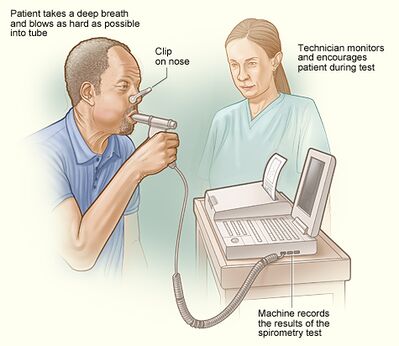Pulmonary function testing (PFT) is a critical diagnostic tool used to assess lung function and identify various respiratory conditions. One essential measurement obtained during PFT is the FEV1/FVC ratio. In this article, we will delve into the significance of the FEV1/FVC ratio, its calculation, and its role in diagnosing lung diseases.

THE FEV1/FVC RATIO
The FEV1/FVC ratio stands for the ratio of forced expiratory volume in one second (FEV1) to forced vital capacity (FVC). It is a crucial parameter used in PFT to evaluate how well a person can exhale air from their lungs during a forced expiration.
SIGNIFICANCE OF FEV1/FVC RATIO
The FEV1/FVC ratio is a valuable indicator of lung health and function. It helps in distinguishing between obstructive and restrictive lung diseases, providing essential information for accurate diagnoses. Here’s how the FEV1/FVC ratio is interpreted:
NORMAL LUNG FUNCTION:
- A healthy individual typically has an FEV1/FVC ratio greater than 70-80%. This indicates that they can expel a significant portion of their lung volume in the first second of forced expiration, and their lung capacity is well-maintained.
OBSTRUCTIVE LUNG DISEASES:
- In obstructive lung diseases like asthma and chronic obstructive pulmonary disease (COPD), the airways become narrowed, making it difficult to expel air. As a result, the FEV1/FVC ratio is reduced, usually below 70%. The FEV1 is disproportionately reduced compared to FVC.
RESTRICTIVE LUNG DISEASES:
- Restrictive lung diseases, such as pulmonary fibrosis, cause a reduction in lung volume. In these cases, both FEV1 and FVC may be reduced, but the FEV1/FVC ratio remains within the normal range or even increases.
CALCULATING FEV1/FVC RATIO
To calculate the FEV1/FVC ratio, a person needs to undergo spirometry, a common PFT procedure. Spirometry measures the amount of air you can forcefully exhale in one second (FEV1) and your total lung capacity (FVC). The ratio is then determined by dividing FEV1 by FVC and multiplying the result by 100 to express it as a percentage.
Which Management Accounting Information Is Vital for Regular Analysis?
VISIT HEALTHSURVIVALIST.COM FOR MORE ABOUT HEALTH OF ANY KIND INCLUDING DEPRESSION, NAUSEA, AND MORE.
The FEV1/FVC ratio is a vital tool in diagnosing and differentiating between various lung conditions. Understanding this ratio helps healthcare professionals assess lung function accurately, enabling them to provide timely and appropriate treatment. Regular pulmonary function testing, including FEV1/FVC measurement, is essential for monitoring lung health, especially in individuals at risk for respiratory diseases.
Please note that interpreting the FEV1/FVC ratio requires a healthcare professional’s expertise, as other factors like age, gender, and personal medical history should be considered alongside the ratio for an accurate diagnosis. If you have concerns about your lung health, consult a healthcare provider for a thorough evaluation.
As an Amazon Associate we earn from qualifying purchases through some links in our articles.
